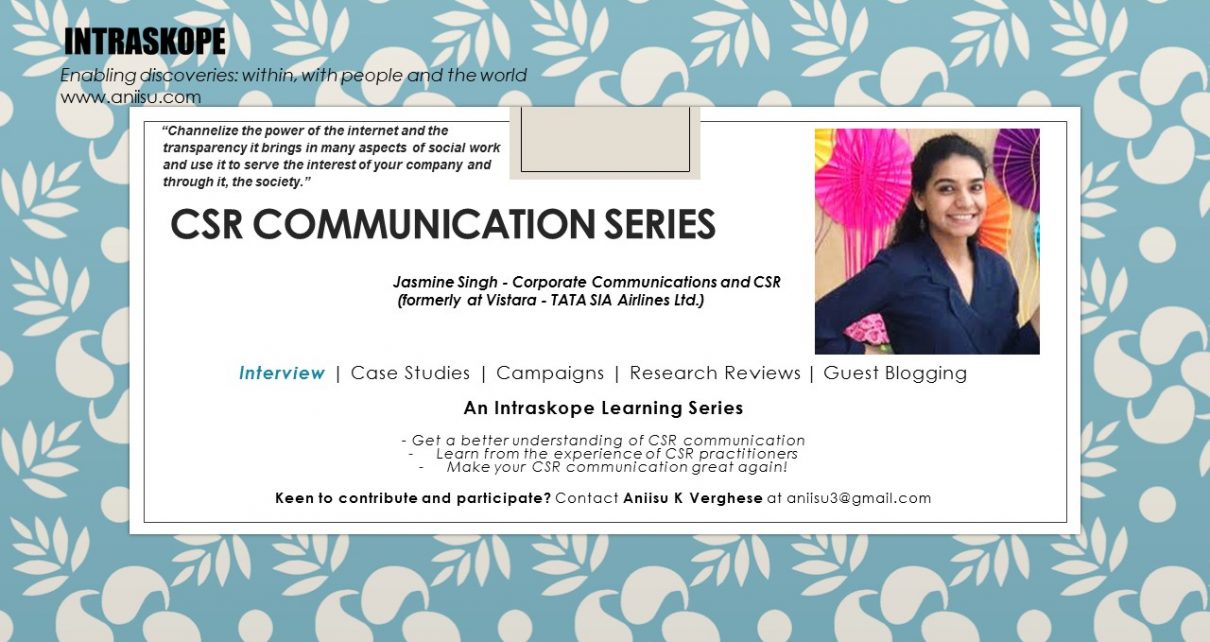This series invites CSR practitioners to share perspectives on the role of communication in making a difference to employee engagement and to the communities organizations serve. In the first edition, Jasmine Singh, a practitioner of communication and CSR discusses her views on the evolving trends in CSR, an interesting campaign at her former employer, Vistara, and the opportunities ahead for those aspiring to make a mark in this field.
Views expressed in this piece are personal and do not reflect the views of the organization referenced.
- How important is CSR communications for your organization and why?
CSR communications is important in different organizations for different reasons. In industries such as chemical refining or lead smelting, for instance, the management may feel it necessary to demonstrate to its internal and external stakeholders that it is working for sustainability in an equal or greater measure than it is contributing to air pollution. This would help stakeholders rationalize their association with such an industry. In some legacy firms, the focus may be on carrying on the tradition of doing good for society, which adds to its pre-established brand value and goodwill. At Vistara, the company I was most recently associated with, we would often craft our internal CSR messages to highlight the deep rooted philosophy of giving back to the society that the company’s parent brands Tata and Singapore Airlines are reputed for the world over. This would help nurture a sense of pride and responsibility towards social action among our internal and external stakeholders.
- What trends do you observe with CSR and related to communicating with internal stakeholders?
There is the obvious and unbridled trend of digitization, which is helping streamline and simplify many processes and communication-related challenges in the CSR space. It allows for greater transparency and accountability. Internal stakeholders can now easily check facts that were previously hard to obtain, such as registration information of an NGO, track how and where their funds or volunteering skills are being utilized, tap into the repertoire on information available on government websites such as the National CSR portal. The workforce today is tech savvy, informed and well-networked. It also knows how to harness the power of social media and the internet to amass opinions, actions and reactions on social issues that impact them or are close to their hearts. CSR is definitely one of the biggest gainers of the digital revolution. So while on one hand it has become easier for CSR teams to organize and communicate about CSR policies, practices and events, employees on the other hand are better equipped to do their bit for the society through volunteering.
- Share how CSR communications is practiced at your organization – who leads it, how is it organized and what are the principles you follow?
CSR Communications have been under the ambit of Corporate Communications in most organizations I have been associated with. Typically, the CSR manager reports to the Head of Corporate Communications, or directly to the Head of HR, and in some cases directly to the CEO of the company. The CSR manager may have executives who support them in crafting communications or organizing CSR activities.While the method and channels of CSR communication vary from organization to organization based on factors such as the organization’s maturity, size, geography, culture and industry, we could broadly classify them into ‘event-based’ and ‘ongoing’. On an ongoing basis, a monthly or quarterly CSR newsletter covering CSR initiatives in the company (the specific unit or the larger firm), current CSR trends, most active volunteers and (if allowed), CSR spends for the period, my personal favorite.The right mix of communications channels is useful in reaching out to all the employees – including those stationed outside of the head office, or those who work in shifts, or on the field. For the latter, mobile updates or intranet access while on the go may come in handy. We align the technological tools available to us for this purpose.
On a more macro level, it is imperative to have a clear idea of which goals related to CSR you wish to drive as an organization. This should be done at the onset when the foundations of the firm are being cast. For us, education for the less privileged, skill building for youth, and environmental action were the three pillars we wished to lay our CSR foundation and strategy on. Trying to cast your net too wide and including various arenas of social action for your employees to work towards may throw them off and the impact may be much lesser.Thirdly, and I have touched upon this in the last question, there is merit in harnessing the collective passion, wisdom and energy of employees and we strive to make things easier for them through our CSR policies and practices. While our CSR focusses on 3 main areas of education, skill-building and environment, and is largely volunteering-based, we also have a payroll giving program for those who also wish to donate funds to their NGO of choice, be it for old age shelters or for providing potable water to drought affected areas. Another example is that family members are encouraged to participate in the company’s CSR initiatives, and employees enjoy paid time-off to volunteer for social work.
- Describe a campaign you are proud of, that resulted in business outcomes or impacted social goal.
A campaign in the space of education that I conceptualized and spearheaded in the airline I was most recently affiliated with, comes to mind. The airline is relatively new in the industry and therefore, funds for CSR were in short supply. Yet, the passion to serve is undying, and one of the focus areas in our CSR strategy was education. In many of our interactions with children in public, government and even non-government schools, we noticed that there is a certain curiosity and thrill that children of most ages associate with aviation. Indeed, many of them harbor dreams of becoming a part of the industry. But as they grew older, perhaps due to lack of knowledge about the various facets of the aviation industry, or because they were hesitant to opt for STEM subjects that are imperative for some of the roles in the industry, many of these dreams would wither away. On the other hand is the dearth of talent in the aviation industry. We felt that there would be merit in educating children about the cogs and wheels or an airline’s operations and doing our bit to bridge this gap in a fun way. We developed a series of comic books which tell simple stories of a family or a group of young friends travelling by air and the questions they have along the way (How does food reach our plates in-flight? Where does the checked-in baggage go? Why do planes sometimes circle the city before landing?).  The books are distributed in check-in counters to children, and we also visit NGOs and schools to distribute them to students. The uptake for the books was immense, with the children devouring the books and coming back to ask when the next edition would be out! The comic also makes for great in-flight entertainment for children, weaning them away from mobile phones at least for the duration of the flight, if not more!
The books are distributed in check-in counters to children, and we also visit NGOs and schools to distribute them to students. The uptake for the books was immense, with the children devouring the books and coming back to ask when the next edition would be out! The comic also makes for great in-flight entertainment for children, weaning them away from mobile phones at least for the duration of the flight, if not more!
5. What advice do you have for CSR practitioners and for those aspiring to join this evolving domain?
In earlier days, core CSR practitioners were hard to come by. Most of them evolved from being HR personnel or Communications Heads to HR/Communication + CSR heads. Many lacked formal training in CSR, and sometimes even the tools that could train and equip them for the additional responsibility. But the situation is different now, with a plethora of good universities and colleges meting out full and part time courses in social work. As a new player in the field, one tends to let emotion get the better of them. But they must never let it cloud their judgement. Due diligence, tracking and reporting, and sustainability of projects are imperatives in the field of social work and sustainability – to be thought through at the onset and never compromised? Channelize the power of the internet and the transparency it brings in many aspects of social work and use it to serve the interest of your company and through it, the society.
6. How can organizations get better with CSR communication?
One important thing to bear in mind as a CSR communicator is that most employees are encouraged to see their CSR contribution acknowledged in a company-wide newsletter. Rewarding and recognizing the drivers of CSR and volunteering in your company will go a long way in establishing a culture of service in the company.Another aspect that is very important in CSR communication is that the leaders of the company must be visible and out there: actively involved in CSR events and conversations. It is not sufficient for employees to keep doing their bit – if they do not feel that their managers or CXOs are as involved in the cause, they tend to undermine its importance. Or they begin to suspect that the leaders won’t condone their spending time and energy on CSR-related pursuits. In the organizations I have been associated with, CSR events would be (as much as possible) inaugurated by the CEO, or at least the divisional heads.
The right medium and frequency of internal communications is also necessary. In my most recent assignment managing CSR and internal communications in an airline, it was not just enough to send an email about payroll giving, or a food donation drive on World Hunger Day, since many employees were based in different cities, or had flight duties with no access to the email for long hours. As such, we paid special attention to posting such information on the company intranet, advising team leaders to have frequent conversations with their team members about upcoming CSR opportunities, arranging the shifts of those in the workforce who wished to participate, and periodically touching base with the out-station teams to ensure that information about CSR initiatives percolated to the deepest level, and that challenges being faced by employees were brought to our notice and resolved at the earliest.
Finally, don’t be restrictive with your CSR policies. Policies such as paid time-off for CSR activities, or reimbursements for partaking in such activities, should be constructed and amply communicated through various internal channels for the information of those interested in joining the CSR bandwagon. Another example of fortifying your company’s CSR initiatives through positive encouragement is inviting family members of volunteers to join in the company’s CSR events.
Interested to participate in the CSR Communication Series? Do drop me a note at [email protected]
Looking for internal communication insights and best practices? Look up the Spotlight on Internal Communication Series.
Have ideas to improve this blog? Do write to me at [email protected]


